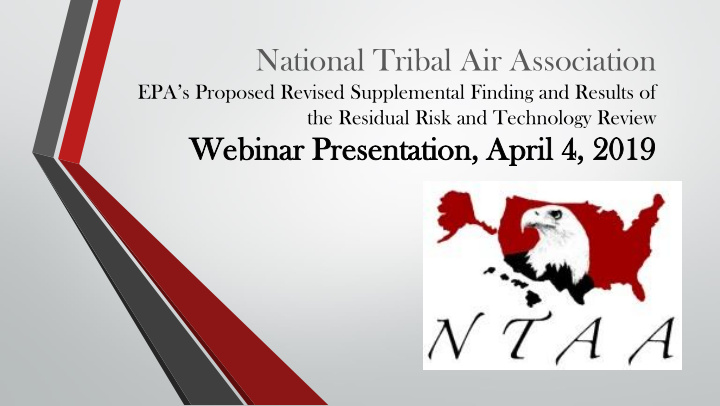



National Tribal Air Association EPA’s Proposed Revised Supplemental Finding and Results of the Residual Risk and Technology Review Web Webinar nar Pr Pres esentation, entation, Ap Apri ril l 4, 4, 20 2019 19
Today’s NTAA Webinar • Welcome and Introductions • Summary of the Proposed Revision • NTAA’s Policy Response Kit • History and CARB Analysis • NTAA Analysis and Comments • Q&A
Today’s Speakers • Andy Bessler, NTAA • Jaime Yazzie, NTAA • William M. Auberle, NTAA Policy Advisory Committee • Shannon Dilley, CARB Senior Attorney and Tribal Liaison
Introduction • Mercury and Air Toxic Standards (MATS) enacted in 2012 • 1 st federal standard to require coal- and oil-fired electric utility steam generating units (EGUs) to reduce mercury and other toxic air pollutants • In June 2015, the U.S. Supreme Court in Michigan v. EPA held that CAA Section 112 requires EPA to consider compliance costs before regulating hazardous air pollutants (HAPs) • In 2016, the EPA issued a Supplemental Cost Finding found the regulation of HAPs emitted by power plants was “appropriate and necessary”
Summary of the Proposed Revision • Rescinding the “appropriate and necessary” finding for EPA to regulate HAPs emissions from coal- and oil-fired EGUs • Proposing the results of the Residual Risk Technology Review (RTR); • Establishing a subcategory for emissions of acid gas HAP from existing EGUs firing eastern bituminous coal refuse • Requesting comments on whether EPA has the authority to remove EGUs from the list of sources listed and rescind (or to rescind without delisting) the MATS rule.
NTAA’s Policy Response Kit to the Proposed Rule • NTAA Fact Sheet • NTAA Tribal Template Letter • NTAA Comment Letter • NTAA Webinar Recording
Basic Structure of CAA 112 • Hazardous Air Pollutants • 1990 Amendments • EGUs different treatment – “necessary and appropriate” finding requirement
Mercury Studies • Mercury Study – Report to Congress (1997) • Utility Air Toxics Study – Report to Congress (1998) • National Academy of Sciences Study – Toxicological Effects of Methylmercury (2000)
History of the Rule • 2000 Utility Air Toxics Determination – 65 Fed. Reg. 79825 (Dec. 20, 2000) • 2005 Clean Air Mercury Rule (CAMR) - 70 Fed. Reg. 28606 (Oct. 28, 2005) • 2005 Revision Rule - 70 Fed. Reg. 15994 (Mar. 29, 2005) • 2012 Mercury Air Toxics Standard (MATS) - 77 Fed. Reg. 9304-01 (Feb. 16, 2012) • 2016 Supplemental Finding - 81 Fed. Reg. 24420 (Apr. 25, 2016)
Three Cases • New Jersey v. EPA , 517 F.3d 574 (D.C. Cir. 2008) • White Stallion Energy Center v. EPA , 748 F.3d 1222 (D.C. Cir. 2014) • Michigan v. EPA , 135 S.Ct. 702 (2014)
California Perspective – Why This Matters • EGUs • Mercury
CARB Tribal Relationship • Overview of the California Air Resources Board (CARB) • < 200 Tribes in California • Executive Order B-10-11
Mercury/Cinnabar – A Natural Resource
Sources of Mercury in the Environment • Natural Sources • Mining • Impurity in Minerals • Burning Fossil Fuels
First Nations of the Great Lakes Great Lakes Commission
Everglades Andrew West, The Fort Myers, Fla., • Miccosukee • Seminole News-Press
MATS • Technology • Economics • Policy Getty/Spencer Platt A coal-fired plant is seen in West Virginia on August 21, 2018.
NTAA’s Recommended Comments for Tribes • Supplemental Finding • Uphold the 2016 Supplemental Finding • Co-benefits • Oppose the finding that the cost of the regulation grossly outweighs the HAP co-benefits • Benefits are already underestimated due to the fact that many human health and environmental benefits are not included in Regulatory Impact Analysis (RIA) • Tribal Impacts • Conduct a benefit analysis that assesses the Rule’s impact on Tribal air quality and health • Subcategory Standard • Should not be established for existing bituminous coal
How Tribes Can Comment EPA has also extended the comment period on this proposed rule to Ap April ril 17, 7, 2019 019. Comments should be identified by Docket ID No. EPA-HQ- OAR-2018-0794 and may be submitted by one of the following methods. • Onli line: Go to https://www.regulations.gov/ and follow the instructions for submitting comments to EPA-HQ-OAR-2018-0794. • Emai ail: l: Comments may be sent to a-and-r-Docket@epa.gov. Include Docket ID No. EPAHQ-OAR-2018-0794 in the subject line of the message. • Mail: Mail: Environmental Protection Agency, EPA Docket Center (EPA/DC), Mail Code 28221T, Attention Docket ID No. EPA-HQ- OAR-2018-0794, 1200 Pennsylvania Avenue, NW, Washington, DC 20460. • Fax ax: Fax your comments to: (202) 566-9744. Attention Docket ID No. EPA- HQ- OAR2018-0794.
ANY QUESTIONS?
Recommend
More recommend